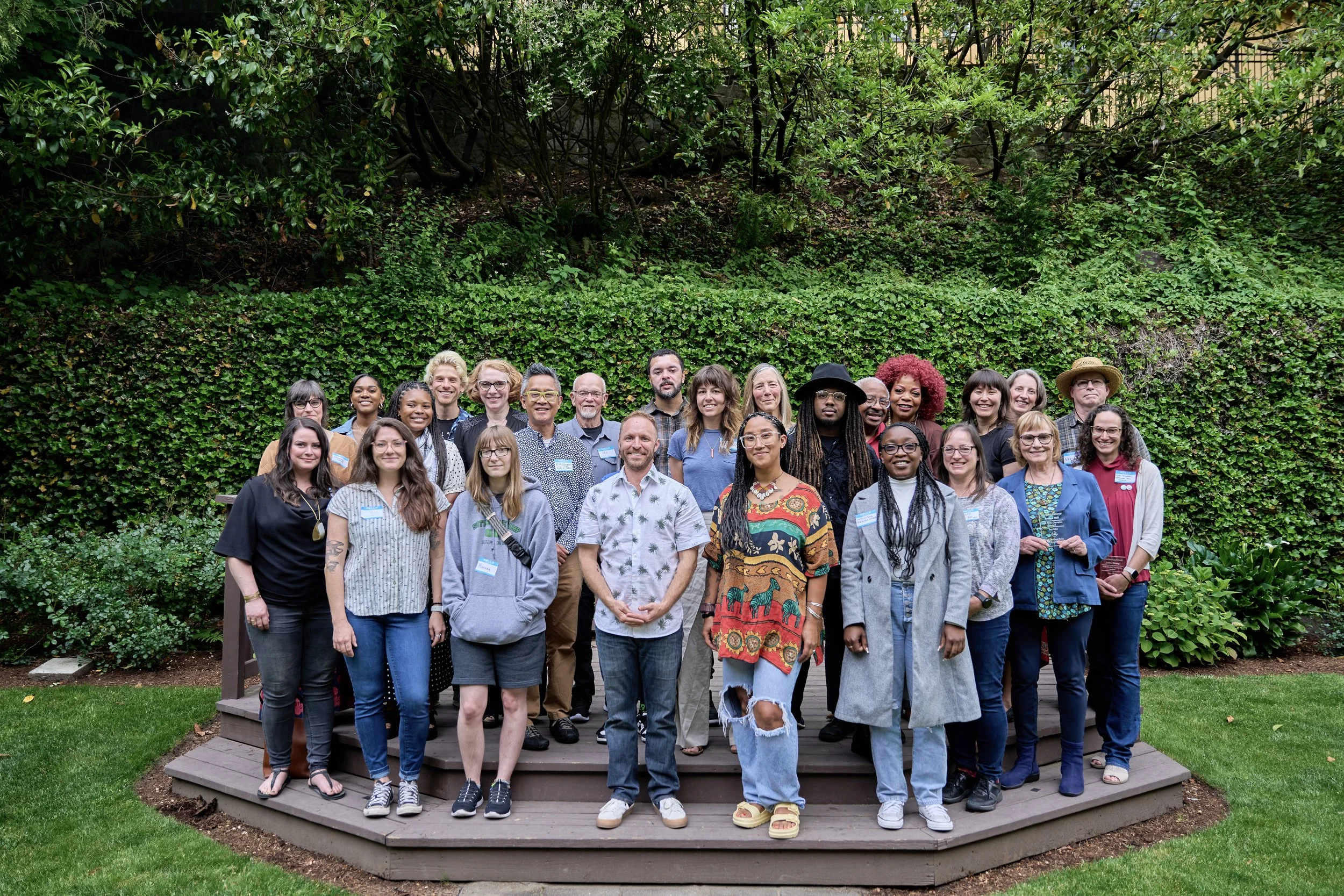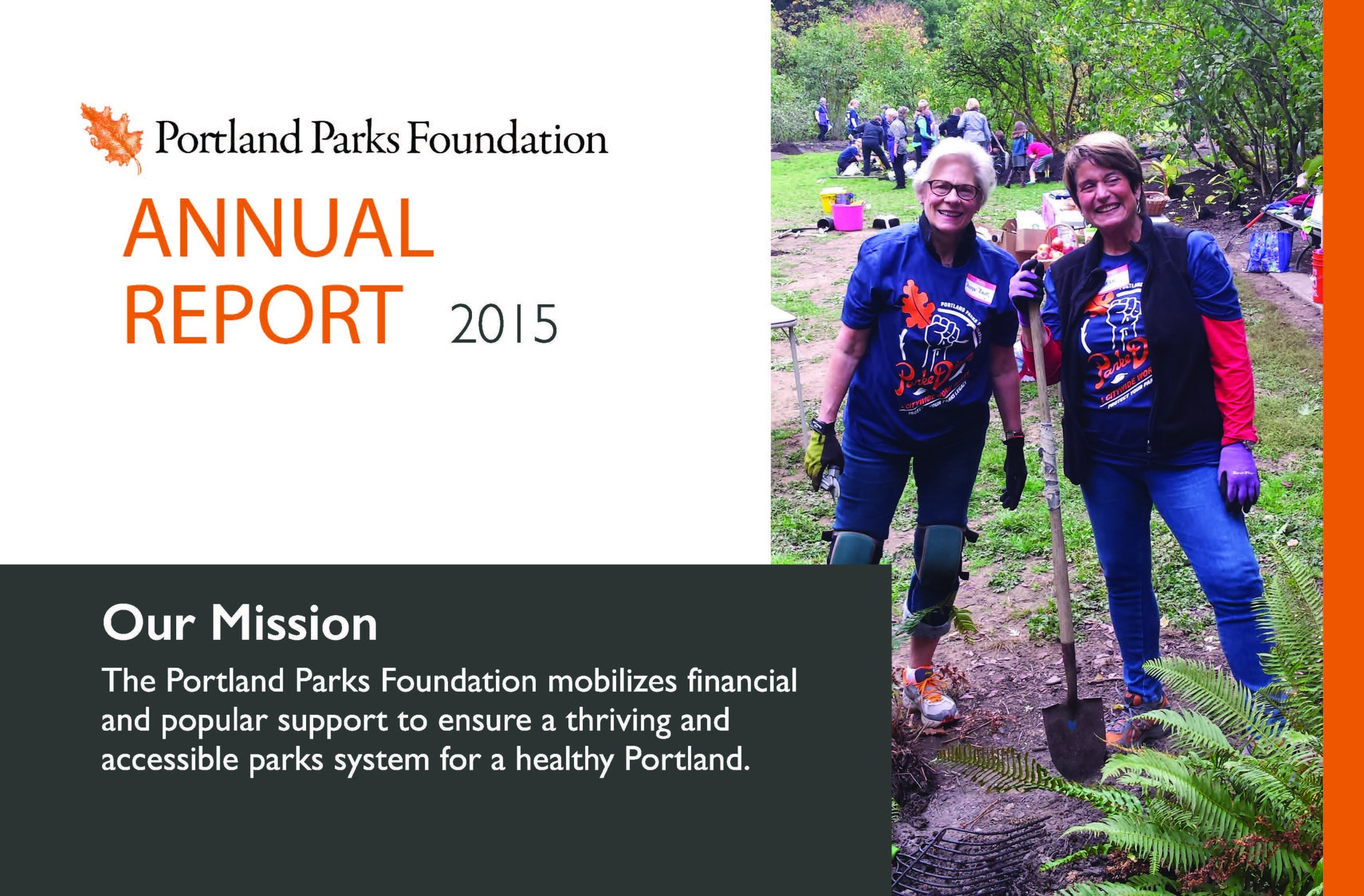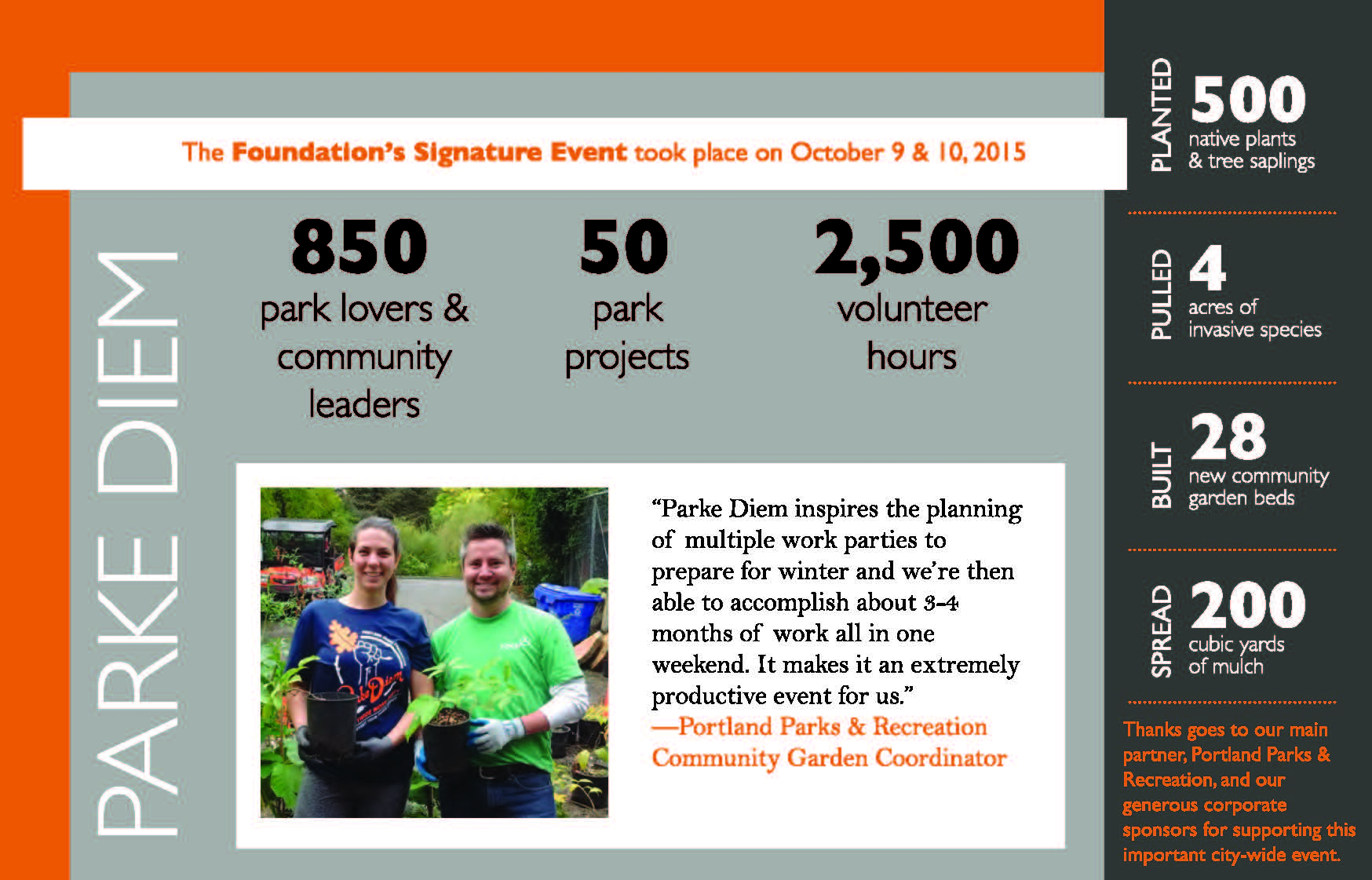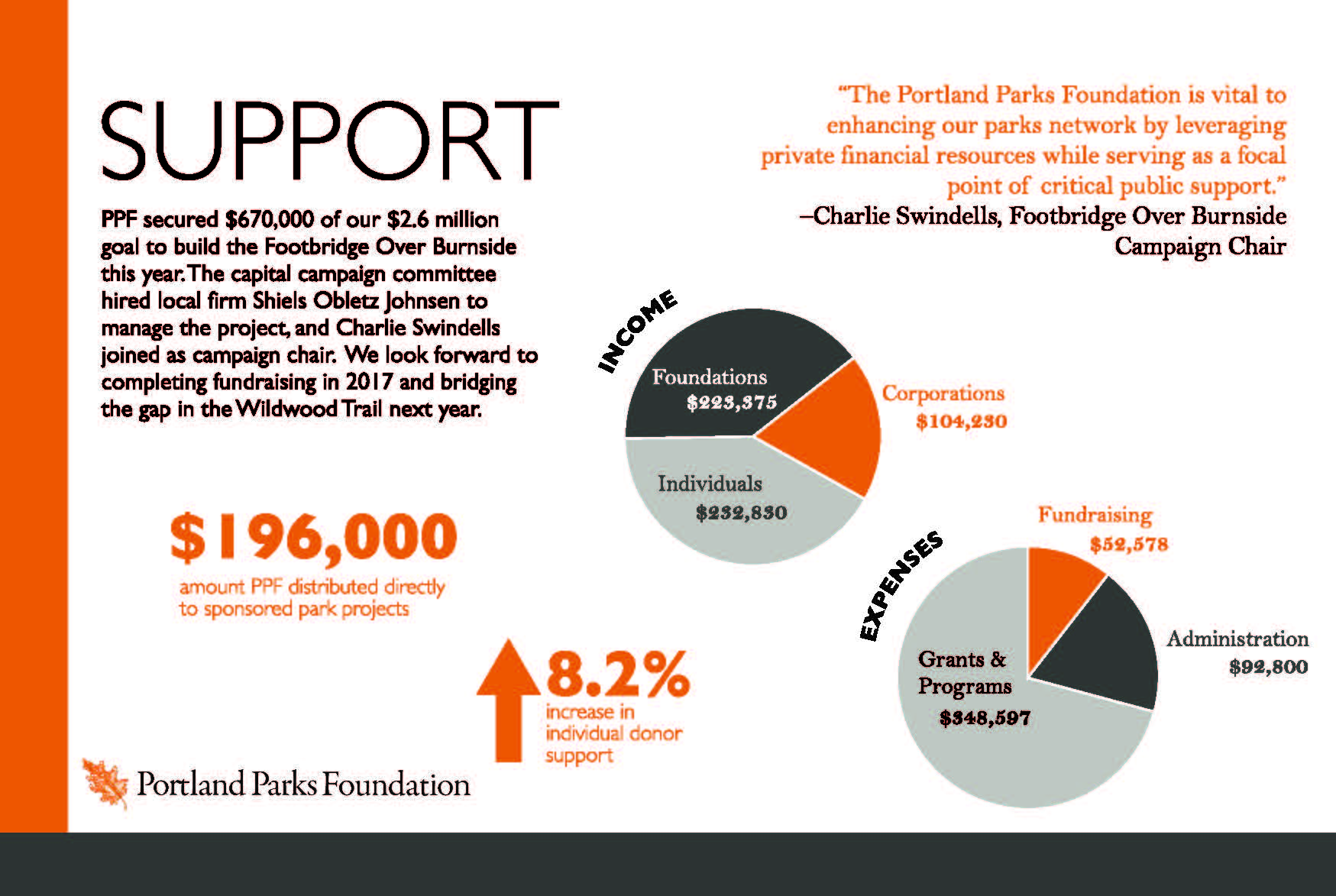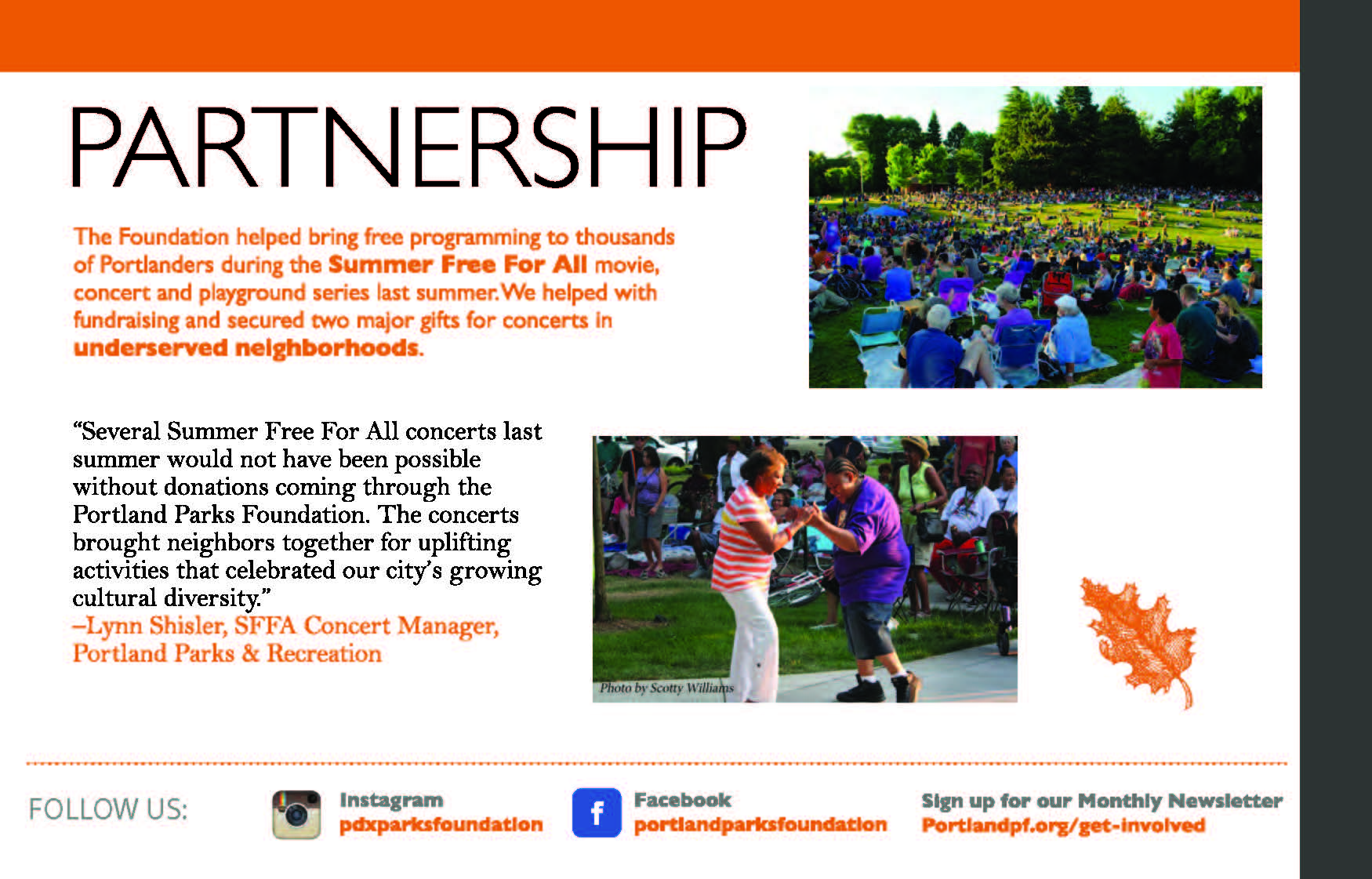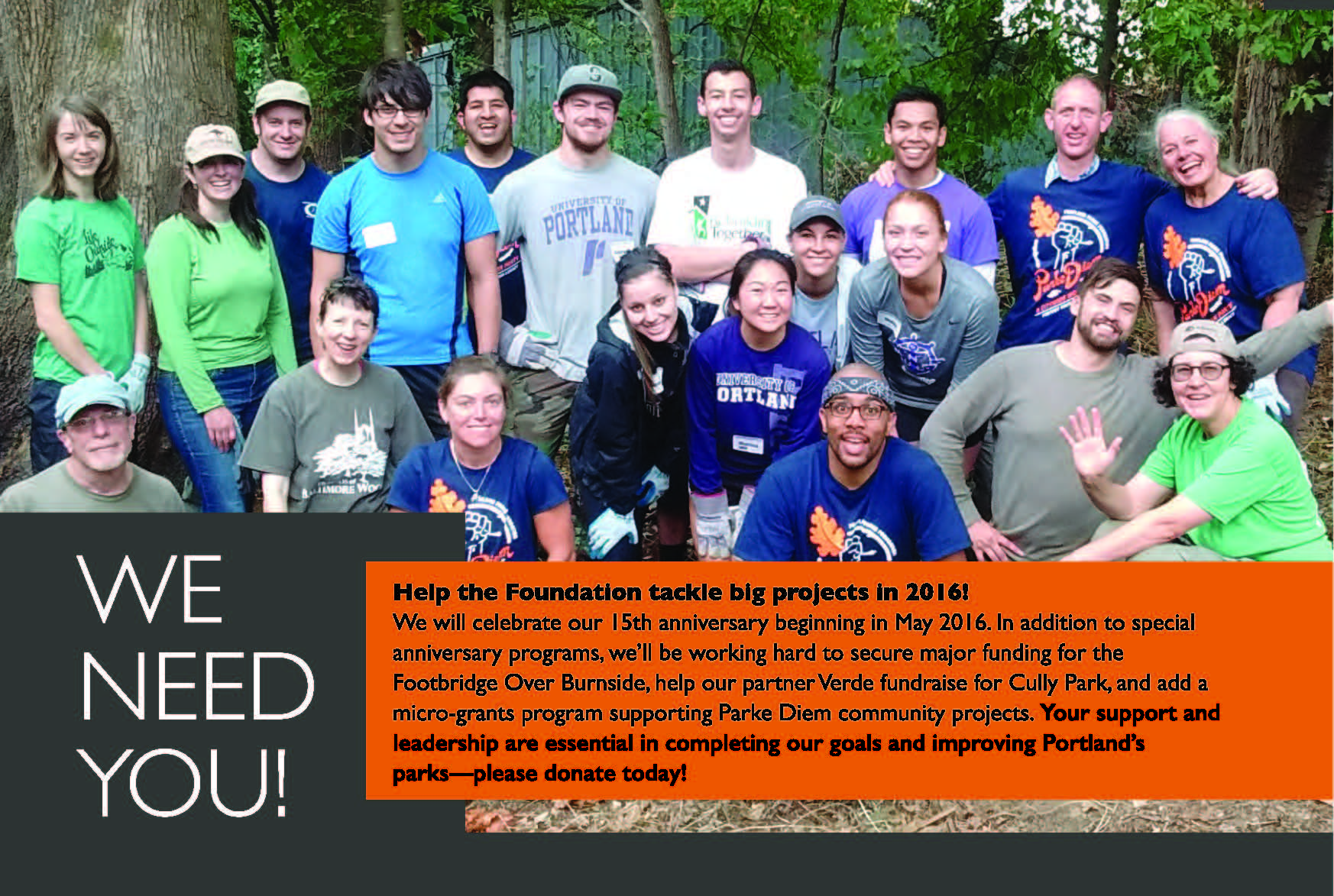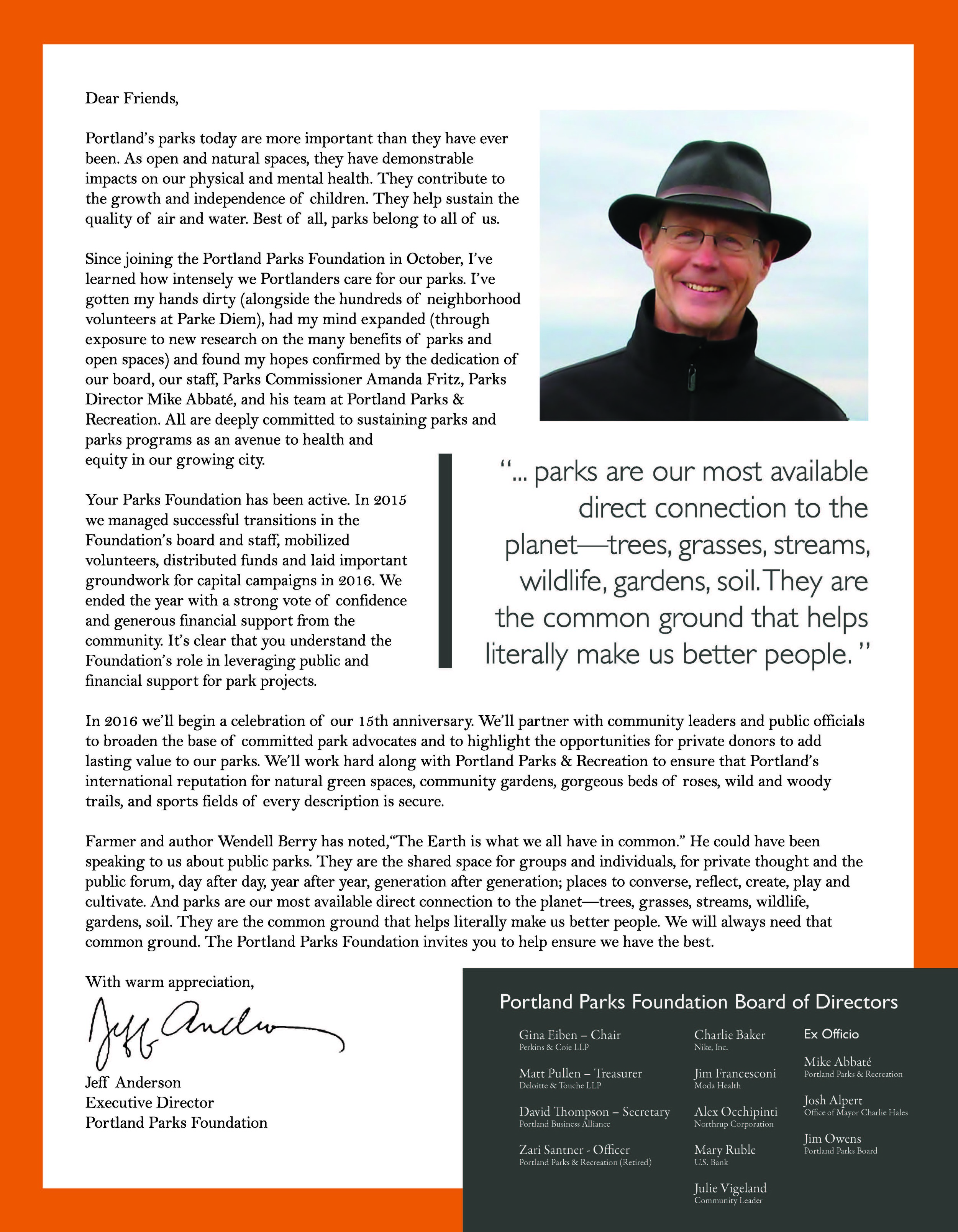Parks Seed Portland Business
Many studies have documented the economic benefits of public parks and nature spaces in cities. Increases in property values, tourism, capital investments and jobs all benefit citizens that live near public parks and natural recreation areas. A 2015 study by the National Recreation and Park Association (NRPA), estimated that local and regional parks generated nearly $2 billion in economic activity in Oregon in 2013 alone.
Portland’s park system is nationally recognized for excellence and has created a buzz that helps Portland businesses recruit some of the best workers in the nation. As one of our board members, David Thompson, Vice President at the Portland Business Alliance said, “Anytime you talk about the region you mention our parks. Companies are looking to locate here because Portland has a high quality of life and parks are one of the most prominent pieces of our quality of life. Parks add direct value to our community and make it a great place to grow your business.”
“. . . Portland has a high quality of life and parks are one of the most prominent pieces of our quality of life.”
David grew up in Portland near Grant Park, and as he said, “Growing up here, parks were my back yard. I learned how to ride a bike and swim in Grant Park.” Now with a family of his own, David’s family spends a lot of time in April Hill and Gabriel Parks near his home. “When a friend approached me to join the Portland Parks Foundation board I jumped at the chance because parks are so valuable to me and my family.”
Portland’s parks are valuable assets for economic activity and bring the city valuable tourist dollars. The same NRPA study aforementioned noted that Waterfront Park generated over $1 million in economic activity in 2013. In 2009 the Portland Parks Foundation helped the Naito family build the Bill Legacy Naito Fountain in Waterfront Park. The fountain continues attract people to the park to gather and play throughout the year. As David Thompson said, “I use parks a lot more than I pay for them. Donating to the Parks Foundation, you can invest in something very specific that the entire community benefits from.”
The Foundation is grateful to our business partners who make parks a priority for their philanthropic investment each year. Those contributions have a measurable impact on park quality and leverage further investment by others through PPF’s campaigns.
Header photo by M.O. Stevens
Native Plants in our Natural Areas
Photos courtesy David Grandfield
Spring has sprung around Portland and it is the time of year to emerge from the house and get outside. Whether it be just in your yard or out for a hike, Portland is home to natural areas that can help you get your wilderness fix. We asked David Grandfield, a Horticulturist working seasonally with Portland Parks & Recreation, and regular Portland Parks Foundation Instagram follower (see David’s beautiful pictures @davidgrandfield), to share some of his favorite natural area parks and native species that you can pick up at local nurseries this spring.
David Grandfield
One of the benefits of living in Portland is our access to natural area parks. ‘Natural area parks’ are the wilder cousins of our typical neighborhood parks; they are larger, have a wild aesthetic, and are managed to promote growth of native plant species. They are also great showrooms for displaying the native trees and shrubs that could work in the little piece of nature in your front or back yard.
Why plant natives? Native trees and shrubs provide food and refuge for wildlife, and best of all pad your pocketbook because after establishment do not require water in hot summer months. Here are a list of 5 Pacific Northwest native shrubs and where you can see them growing in their natural habitat at Portland natural area parks:
Red Flowering Currant [shown above]
This fragrant shrub is one of the first to bloom in late winter, it's pink flowers attract hummingbirds and bumblebees. It can grow up to 8 feet, and will survive in full sun with little to no water in the summer. This is one of the most widespread plants in Portland natural area parks, and can be found in Southeast Portland alongside walking trails in Oaks Bottom Wildlife Refuge.
Douglas Spirea
This shrub usually stays about 5 feet tall and has deep pink blooms in midsummer. Although this plant can handle dry landscapes, it does best in wet areas in full sun. Its brown seed heads add texture to landscapes in winter months. It can be found in East Portland growing at Tideman Johnson Natural Area and near Powell Butte Nature Park.
Indian Plum or Osoberry
This versatile shrub can grow in full shade or full sun and has drooping white blooms in early February. It’s small, raisin sized fruit are a favorite food for birds in late summer. Whitaker Ponds Natural Area in Northeast Portland is a great place to see Osoberry shrubs.
Blue Elderberry
This large shrub is widespread in Pacific Northwest landscapes. Its large clusters of creamy white blooms emerge in early spring and then turn into small powdery blue berries toward late summer. Although it naturally grows up to 30 feet tall, it can be kept around 10 feet tall in home landscapes with regular pruning. One great place to see Blue Elderberry is Foster Floodplain Natural Area in Southeast Portland.
Big Leaf Lupine
This plant is not as large as the others listed above, it stays about 12 inches tall and produces a tall spike of purple flowers in late spring. It does best on stream banks and open meadows in full sun. Many species of lupine can be found on the hillsides of Madrona Natural Area Park in North Portland.
Portland Parks Foundation encourages you to visit your Portland natural areas and sign up to volunteer for the many planting and clean-up parties throughout the year or at Parke Diem. It is amazing that we have such wild areas that provide recreation, habitat and solace so close to the city, and we need your support to keep them beautiful!
Parks Part of the Urban Ecology Web
Dr. Alan Yeakley, Director of the School for the Environment at Portland State University
Parks and open space provide an environmental support system for Portland to thrive. According to a Portland Parks & Recreation report, parks and street trees alone provide nearly 414 million gallons of storm water filtration and remove more than 25 million pounds of carbon dioxide, nitrogen dioxide, ozone, particulate matter, and sulfur dioxide from the air each year in Portland. This green infrastructure benefits people and wildlife alike and raises the quality of life for everyone in the area.
To better understand how parks contribute to the environmental health of our city, last month I attended the Urban Ecosystem Research Consortium’s (UERC) Symposium at Portland State University and sat down with one of the group leaders, Dr. Alan Yeakley, Director of the School for the Environment at Portland State University.
For those who haven’t heard of UERC, it is a group of people from all backgrounds and disciplines working together in the Portland and Vancouver area “. . . to advance the state of the science of urban ecosystems and improve our understanding of them. . .” They host free brown-bag talks throughout the year and an annual symposium each winter.
The UERC Symposium harkened back to the ‘web of life’ lessons we all learned in elementary school except with one very important twist - it was evident at UERC that it takes a web of humans from a large number of disciplines, as well as the right combination of plants, animals, soil and streams to maintain a positive relationship with nature in our urban landscape.
I asked Dr. Yeakley about this emphasis on cross-disciplinary work in environmental research today. “Urban ecology is becoming more and more integrated, connecting natural scientists with social scientists,” said Dr. Yeakley. Especially in urban areas, the part that humans play in the conservation or degradation of natural resources is large. “There is so much research going on and it is important to understand the political and economic factors that influence the conservation effort,” said Dr. Yeakley
In the Portland area, economic impacts of flooding events and governmental regulations, especially around endangered species, have spurred much of the habitat restoration investment in the past several decades. Citizens have increasingly advocated for green infrastructure and voted to provide tax dollars for projects and research to make our city’s environment healthy for future generations.
From the work of the agencies, universities, non-profits as well as private citizens, a sample of which was provided in the research presentations at UERC, it is evident that Portland’s parks are an important resource for understanding and maintaining the environmental health of our city. Private funding from individuals and organizations is an important ingredient to enhance sustainable management of our urban environment. The Portland Parks Foundation is committed to a thriving park system for a healthy Portland, and research from local scientists affirm the importance of our mission.
Read the UERC Symposium materials at: http://www.uercportland.org/annual-symposium
Kid-Tested Spring Break Playgrounds
Photos courtesy Keri Hepner on Instagram at klhepner
Spring break is around the corner, so we asked local 9-year old park expert, Josh Hepner, for his top 10 park destinations for your Portland staycation.
Josh became a park expert when he set a goal in 2015 to visit as many parks as possible. PPF followed his adventures on Instagram when he used the #parklandia hashtag. Josh said, “One day after school we wanted to go to a park to enjoy the nice weather and play – but we had been going to the same neighborhood park over and over and decided to go to a different park. My mom picked Peninsula Park because the roses were blooming. This started our journey to try and visit every park in Portland.”
We asked Josh what he would do if he had unlimited money for parks. He said, “I would put a skate park and water feature in every park. I would also invent something to make swings keep swinging once you hit the ultimate height.” That might take some time for PPF and Portland Parks & Recreation to achieve, so in the meantime here are Josh’s top 10 parks picks (in no particular order):
10. Senn’s Dairy Park: This one was so fun!! I could have played at this one all day; it’s always fun to sit inside of a rocking chicken.
9. Glenhaven Skatepark: Some of my first skateboarding was done here, this one is close to my house, so it doesn’t take too long to get there.
8. Northgate Park: It was a really hot day when we went to this park, it was fun to climb on the spider web thing and the water feature was really awesome.
7. Pendleton Park: I liked the old merry-go-round the best; my little brother loved the big rabbit that is off to the side.
6. Wellington Park: This one is in my neighborhood and close to my school. I can walk there so I go there a lot. There’s a great view of Mt. St. Helens on a clear day.
5. McKenna Park: The monkey bars were awesome, and there were guys playing a basketball game that I watched.
4. Ivon Street Park: This small little corner park was actually a lot of fun. The slide was fun to go down on my belly, and it had cool swings.
3. Patton Square Park: We were driving by and just decided to stop at this one, and I’m glad we did. We didn’t spend too much time there but plan on going back again because those things that twist up and down while you sit on them were fun.
2. John Luby Park: This park was nice a shady when it is hot, and really big! And again, the monkey bars were awesome.
1. The Fields Park: [Picture in banner] We had a picnic in this park, and even though I hurt my elbow in this park, we got to play in the sand until the sun went down.
Thank you to Josh and Keri Hepner for this totally awesome list of kid-tested parks. We’ll continue to follow you on Instagram and watch for more fun park visits!
Cully Update: Construction Begins on NE 72nd Ave Greenstreet
Excerpts Re-posted with permission by Anna Gordon of Living Cully
Running north from its intersection with NE Killingsworth, today’s NE 72nd Ave is one of Cully Neighborhood’s many forgotten streets – an 860lf crumbling asphalt street with no stormwater infrastructure: no curbs, no storm sewer, no sumps, and a shoulder that collects and ponds stormwater. It ends at the entrance to the Community Garden, but lacks sidewalks, appropriate lighting, and other pedestrian safety features. Verde, together with minority-owned contractors Colas Construction and Raimore Construction, began rebuilding NE 72nd Avenue in late 2015, and anticipate that we will complete construction by April 2016.
“Enhancing local infrastructure contributes to community pride, safety and future opportunity.”
PPF asked Luis Lopez, Project Engineer at Probity Builders about the project. He explained that the project's design goes well beyond city requirements and includes other benefits like 9 bio-swales, 1 storm water facility, 11 pervious (porous) vehicle parking stations and sidewalk, and native plantings throughout the entire street. As Lopez said, "My favorite feature of the street is the vehicle parking areas. The street incorporates pervious parking areas that benefit neighbors while helping manage stormwater."
By building NE 72nd Greenstreet, Verde improves water quality, educates youth, provides diverse and local green job and business opportunities, improves pedestrian and bicycle mobility, and tests a community-based model for Greenstreet development. "The 72nd Ave Green Street improves and benefits a community long overlooked and underserved. Enhancing local infrastructure contributes to community pride, safety and future opportunity,"said Lopez.
Verde hopes to complete the project by next month, and we look forward to celebrating their new gateway to Cully Park together.
To see the original post visit the Living Cully Website
New Footbridge Campaign Chair and Case Statement
New Footbridge Over Burnside Chair Charlie Swindells
The Foundation is in the midst of a campaign to build a footbridge over Burnside where the iconic Wildwood Trail crosses from Washington to Forest parks. Local attorney and philanthropist Charlie Swindells recently joined the effort to chair the Footbridge Over Burnside campaign. We asked Charlie to describe his passion for parks and why he supports the footbridge project.
How have Portland’s parks played a role in your life?
A couple days after my family moved to Portland in 1974 (my summer before 5th Grade), my mom took me to Hoyt Arboretum. She wanted to ease my shock of "moving to the big city” by exposing me to the extraordinary beauty there. I decided maybe Portland wouldn’t be so bad after all!
Since then, my lifelong enjoyment of Forest Park has been measured in dog years — three dogs have been my personal trainers on the Wildwood Trail since high school, and my newest hiking partner is named Marsha. Her ecstatic first day on Wildwood after moving from a kennel in San Francisco is probably my favorite park memory.
Why did you decide to chair the Footbridge Over Burnside campaign?
I am excited to serve as the campaign chair for the Footbridge Over Burnside because my wife and I drive through the Wildwood-Burnside intersection daily. Even from inside our cars we can feel (and share) the fear and frustration of trail users waiting to "make a run for it." With current traffic levels, the Wildwood Trail is now effectively closed at that intersection for most trail users most of the time. The Footbridge is an elegant solution that will be a destination in its own right for generations to come.
What do you think a robust park system does for Portland?
Portland's parks mean different things to different people, but the connection they provide to our Pacific Northwest natural heritage is something we all share in common. The Portland Parks Foundation is vital to enhancing our parks network by leveraging private financial resources while serving as a focal point of critical public support.
Why do you support the Foundation?
Parks can be too easily short-changed when diverse constituencies are lobbying aggressively for scarce public dollars. As our region becomes more intensively developed, we can’t afford to neglect this community life support system. Support for the Portland Parks Foundation ensures that our invaluable park system is maintained and expanding to serve future generations.
Securing South Park Blocks' Future
Friends of South Park Blocks at Parke Diem
Walking through the South Park Blocks, it is easy to see why visitors and residents alike find them alluring. The South Park Blocks combine art, architecture and beautiful gardens to engage the visitor in Portland’s history and future all in just a few steps. Cultural institutions like the Portland Art Museum, Oregon Historical Museum, Portland’5 Centers for the Arts, Portland State University, many historical churches and two farmer’s markets all call the park home.
That is why Gunnar Sacher and David Newman got together in 2011 to improve and protect this important community resource. The Portland Parks Foundation started supporting the Friends of South Park Blocks (FoSPB) in 2014 by sponsoring garden bed improvement in the Lincoln Block. Today, the Friends of South Park Blocks serve as an example of the positive difference involved citizens can make in parks, and the Foundation is proud to call them a partner.
“The South Park Blocks are not your traditional park – they are the heart of where Portland started, and today are the first cultural address for people visiting,” said Mr. Sacher. The
group works to improve the South Park Blocks’ safety, beauty and the park’s overall support in the community. The list of projects they’ve completed is long and includes: planting new garden beds, facilitating business utilization of the parks, conducting a research project to find the best turf for its high-use and shaded lawns, supporting healthy trimming of the tree canopy, improving and maintaining its rose beds, patrolling and reporting illegal activity in
the park, conducting educational park ‘safety summits’ with local officials, businesses and residents, and recruiting volunteers to give time to clean and maintain this heavily used park.
Their work on park safety was one of their first, and continues to be a priority for the group today. “To be accessible, parks need to be safe for everyone. That is why one of our first projects was to support creating the city-wide park ranger program,” said Mr. Sacher. Unfortunately, due to limited resources and re-prioritization of other parks the Friends of South Park Blocks saw a decrease in park ranger patrols in the past year. As a result, the group reinvigorated the idea of Safety Summits with local officials and residents to talk about how to decrease illegal activity in the park and increase overall safety. So far they’ve learned what regulations exist, how those rules are enforced and collected incident metrics. FoSPB will continue the summits in 2016 to come up with ideas and volunteers to maintain and encourage new positive social activity and minimize unwanted social behavior in the park.
In the coming year FoSPB hopes to recruit more of the approximately 3,000 neighborhood residents (not including nearby PSU students) to give back by supporting their campaign to install new fencing in the Lincoln Block, increasing positive activity in the park through the foot patrol or other community events, and leading new maintenance teams to beautify the park. “If you live and use services in the neighborhood, you should also give back and participate. We want to feel safe and comfortable in our neighborhood, and this is the best way to contribute and make that happen,” said Mr. Sacher.
The Portland Parks Foundation is excited to support the Friends of South Park Blocks outreach efforts this year. You can keep tabs on their work or to volunteer your time by visiting the Friends of South Blocks here.
Romantic Park Picks
Do Valentine’s Day the Portland way by taking your significant other outside in a park this year. Here is a list of our top romantic park spots to get you in the mood.
1. Chinese Garden New Year Celebration: gardens illuminated by hundreds of lanterns and traditional music and performances combine for an unforgettable evening.
2. Crystal Springs Rhododendron Garden: The pathways and bridges guiding you and your sweetheart around this spring-fed oasis are romantic any time of year.
3. Leach Botanical Garden: The quiet paths and magical plants spanning Johnson Creek in this historic botanical garden will enchant your valentine.
4. Tanner Springs Park: Renew your love at the site of an unearthed wetland pond once buried beneath the industrial landscape. While small, this park allows plenty of space for quiet reflection and sweet nothings.
5. Washington Park Rose Garden: This park always has a way of blooming love in the hearts of Portlanders and visitors alike any time of year. Step into the Shakespeare garden and recite your favorite sonnets for an added romantic effect.
6. South Waterfront Park: If you haven’t been to the new park space along the south waterfront it is a perfect date night destination. Get in early for a waterfront dinner and then digest on alcove seating surrounding garden planters and pools. Skip stones from the south waterfront beach to round out the experience.
7. Broughton Beach: Romance is in the air at this beach. A sandy beach and sailboats slicing through the majestic Columbia River makes for a perfect stroll arm-in-arm.
8. Laurelhurst Park: The weeping willows and paths around the lake in Laurelhurst Park are a picturesque backdrop for a budding romance.
9. Peninsula Park: Over 10,000 crocus blooms will delight you and your date in this historic park known for its summer rose displays. If it is drizzling during your visit, the National Heritage designated pavilion is a great place to sip hot chocolate and overlook the gardens.
Parks Building Community
Som Nath Subedi, Parks for New Portlanders manager, accepting a 2015 Spirit of Portland award with Commissioner Amanda Fritz.
To find out more about how you can get involved, contact Som Nath Subedi at som.subedi@portlandoregon.gov or visit the program’s website.
According to a recent report by the City Budget Office, roughly 15% of Portlanders were born in countries other than the United States– that puts the Rose City right in line with about 50 other large U.S. cities. Unfortunately, for many of our newest Portland citizens, parks and community centers are literally a foreign concept. That is where one of Portland Parks & Recreation (PP&R)’s newest programs, Parks for New Portlanders, steps up to welcome immigrant and refugee families into our public park spaces and programs.
The Parks for New Portlanders program started about a year ago to help immigrant and refugee families engage with and to utilize their city’s parks and recreational programs via PP&R. Since its inception, it has conducted soccer and basketball tournaments which cater to immigrants and refugees, along with culturally-specific community gatherings in Portland’s parks. The program also hired seven Community Youth Ambassadors to help organize culturally-specific recreational activities for their communities. In the Parks for New Portlanders Program’s first year, it attracted youth and families from around 40 countries and their disparate cultures, gaining important momentum for this year’s goals. The program made a welcome video in 10 different languages watched by 50,000 people last summer.
Why is culturally-specific programming in parks and recreation so important? Parks are one of a handful of places that belong to all citizens, and are one of the hallmarks of America’s democracy.
“Our community lives, eats and invests together. They are our valued partners, rather than just some needy population,” says Som Nath Subedi, PP&R Program Coordinator for Parks for New Portlanders. “Parks for New Portlanders is a way for our city’s immigrant communities to connect to their new home. It shows them that even though they are newcomers, that the city and all it offers belongs to them. City activities belong to them. City resources belong to them. We believe in recreation and access for ALL Portlanders. And PP&R is leading that effort.”
Regardless of economic status and backgrounds, people come to parks to be social and to meet neighbors, celebrate with family, to exercise and take needed respite from worries; to connect with nature. However, if parks and recreational activities are an entirely new concept, it can be difficult to access or enjoy these public gathering spaces.
“Many refugee families come from very difficult and dangerous circumstances to start their new lives in Portland. Parks can help with the healing process and show them that they are welcomed in their new home,” adds Subedi. “This program bridges the recreational gaps and provides opportunities for access to Portland Parks & Recreation services and activities.”
Subedi knows this experience first-hand. He immigrated to the U.S. in 2008 after living 20 years in a Bhutanese refugee camp in Nepal after being forced out of his native country of Bhutan. As he said in a recent Oregonian article, when he first came, “Daily life was very unpredictable. From using a bus to grocery shopping, and being unemployed and trying to find a job, made each day overwhelming for us. We would easily become lost on big crowded streets filled with cars and big buildings. Anxious and tired, we realized that we had no idea how complex living in America would be." Som hopes his work with PP&R will help new families integrate and flourish in Portland.
This coming year the Parks for New Portlanders program hopes to expand its programs to reach even more families. The Portland Parks Foundation looks forward to following this program’s successes and supporting our local parks that are the center of our communities. To find out more about how you can get involved, contact Som Nath Subedi at som.subedi@portlandoregon.gov or visit the program’s website.





